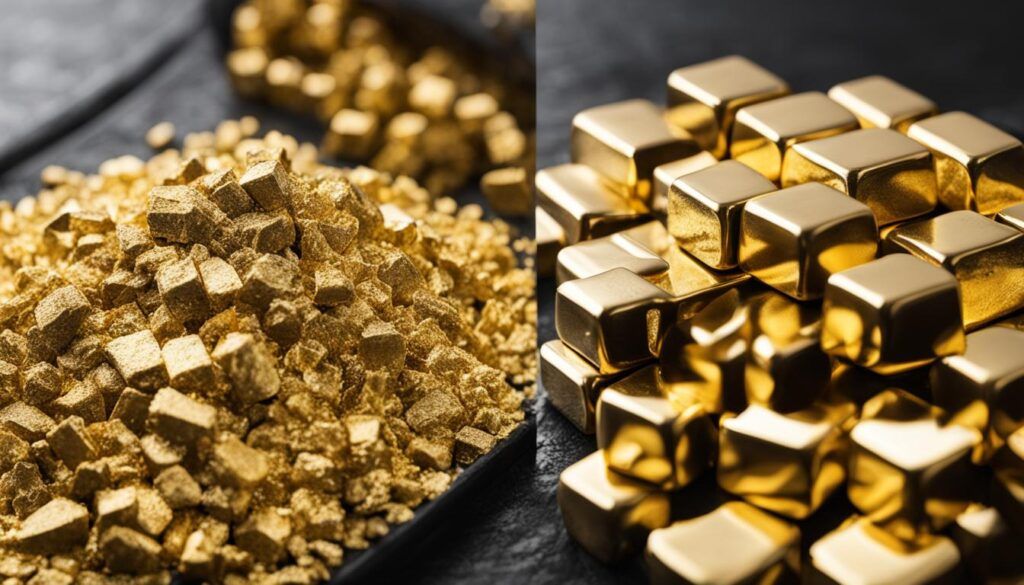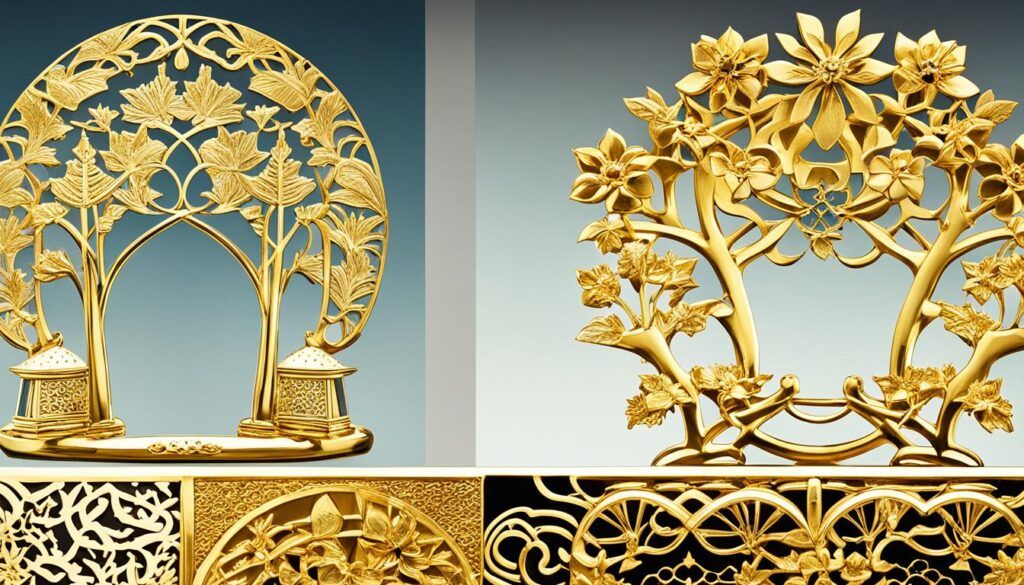Investors and collectors are often drawn to the allure of gold, a universally recognized valuable commodity. When it comes to gold, two prominent types that frequently pique interest are Saudi Gold and Japan Gold. While both hold their own merits, understanding the differences in origin, quality, and value can help determine which may be the best investment option.
Key Takeaways:
- Saudi Gold and Japan Gold are two distinct types of gold worth comparing.
- The origin of Saudi Gold lies in Saudi Arabia, while Japan Gold is sourced from Japan.
- Gold quality is not solely determined by its country of origin but rather by karat weight and metal composition.
- The value of both types of gold is subject to market demand, scarcity, and craftsmanship.
- While Saudi Gold is known for its warm yellow color, Japan Gold may have a slightly different hue due to variations in metal composition.
The Origin of Saudi Gold and Japan Gold
When it comes to Saudi Gold vs Japan Gold, one of the key factors that sets them apart is their origin. Saudi Gold refers to gold that comes from Saudi Arabia, a country known for its rich reserves and history in gold production. On the other hand, Japan Gold is sourced from Japan, a nation with a strong cultural affinity for craftsmanship and attention to detail.
Understanding the origin of these types of gold provides valuable insights into their characteristics and unique features. Let’s delve into the specifics of Saudi Gold and Japan Gold to gain a deeper understanding of their origins.
The Origin of Saudi Gold
Saudi Arabia, being one of the largest gold producers in the world, has a long-standing history of gold mining and refining. The country’s gold reserves are primarily found in the Arabian Shield, a region known for its extensive mineral deposits. Saudi Gold carries with it the legacy of skilled artisans and the rich heritage of the Middle East.
The Origin of Japan Gold
Japan, despite not being a major gold producer, has a unique approach to gold refinement and craftsmanship. The country’s gold reserves may be limited, but Japan Gold stands out for its meticulous attention to detail and exquisite designs. Japanese artisans have refined the art of goldsmithing over centuries, creating intricate and breathtaking pieces that showcase their expertise.
In summary, Saudi Gold originates from Saudi Arabia, a country with a rich history in gold production and craftsmanship. Meanwhile, Japan Gold is sourced from Japan, known for its meticulous attention to detail and precision in goldsmithing. Understanding the origin of these gold types enhances our appreciation for their unique qualities.

Stay tuned to uncover more about the quality, value, appearance, and cultural significance of Saudi Gold and Japan Gold in subsequent sections.
Quality of Saudi Gold and Japan Gold
When comparing Saudi Gold and Japan Gold, the quality of the gold is an essential factor to consider. Both types of gold can come in different karat weights, such as 18k or 24k. The karat measurement indicates the percentage of gold in the alloy, with higher karat weights indicating a higher purity of gold.
It’s important to note that the quality of gold is not determined by its country of origin but rather the karat weight and the mix of metals used. A higher karat weight signifies a greater amount of pure gold in the alloy, making it more valuable and desirable to investors and collectors.
Here is a comparison of the gold purity levels for Saudi Gold and Japan Gold:
| Gold Type | Karat Weight | Gold Purity |
|---|---|---|
| Saudi Gold | 24k | 99.9% pure gold |
| Japan Gold | 18k | 75% pure gold |

As shown in the table, Saudi Gold with a karat weight of 24k has a higher gold purity level of 99.9%, while Japan Gold with a karat weight of 18k has a gold purity level of 75%.
It’s important for buyers to consider their preferences and investment goals when deciding between the two, as the higher karat weight of Saudi Gold offers a greater percentage of pure gold, while Japan Gold may have a lower gold purity due to the inclusion of other metals in the alloy.
Value of Saudi Gold and Japan Gold
The value of Saudi Gold and Japan Gold is determined by several key factors, including market demand, scarcity, and craftsmanship. Each type of gold has distinct characteristics that contribute to its overall value and appeal.
Saudi Gold: Saudi Gold is highly valued for its superior karat weight and intricate designs. Gold from Saudi Arabia is known for its purity and high gold content, making it an attractive investment option for collectors. The intricate craftsmanship of Saudi Gold pieces adds to their overall value, as they are often considered exquisite works of art.
Japan Gold: On the other hand, Japan Gold is renowned for its precision and craftsmanship. The meticulous attention to detail and dedication to quality make Japan Gold highly sought after by collectors. The skill of Japanese artisans is reflected in the refined beauty of each piece, making Japan Gold a valuable addition to any collection.
Ultimately, the value of both Saudi Gold and Japan Gold is subjective and influenced by individual preferences and market dynamics. While Saudi Gold may be prized for its higher karat weight, intricate designs, and purity, Japan Gold stands out for its precision, craftsmanship, and refined beauty.
| Factors | Saudi Gold | Japan Gold |
|---|---|---|
| Market Demand | High | High |
| Scarcity | Varies based on design and availability | Varies based on design and availability |
| Craftsmanship | Intricate designs | Precision and refined beauty |
| Overall Value | High | High |
In summary, both Saudi Gold and Japan Gold hold significant value in the market, albeit for different reasons. Saudi Gold’s allure lies in its higher karat weight and intricate designs, while Japan Gold stands out for its precision craftsmanship and refined beauty. Ultimately, the value of each type of gold depends on individual preferences and the ever-changing dynamics of the market.

Differences in Appearance and Color
While both Saudi Gold and Japan Gold are made of the same precious metal, their appearance and color may differ. The color of gold is determined by the mix of metals used in the alloy. Saudi Gold is often known for its warm, rich yellow color, while Japan Gold may have a slightly different hue due to variations in the metal composition. However, it’s important to note that these differences in color are not solely attributed to the country of origin but rather the specific alloy mixture.

Visual representation of the differences in the color of Saudi Gold and Japan Gold:
| Saudi Gold | Japan Gold |
|---|---|
| Warm, rich yellow | Slightly different hue |
Market Analysis of Saudi Gold and Japan Gold
Understanding the gold market is crucial when considering investments in Saudi Gold and Japan Gold. The dynamics and complexity of the gold market can directly influence the value and availability of these precious metals. Factors such as global demand, economic conditions, and geopolitical stability play significant roles in determining gold prices. To make informed investment decisions, it is essential to stay informed about market trends and consult with experts or trusted sources for accurate analysis and insights.
When assessing the gold market, investors often rely on various indicators, such as gold pricing and comparison charts. These tools provide valuable information for understanding price fluctuations and market trends. Analyzing the performance of Saudi Gold and Japan Gold against other investment options enables investors to make informed decisions based on market analysis.
The Gold Market: Key Factors
To gain a comprehensive understanding of the gold market, it is important to consider the following key factors:
- Global Demand: The demand for gold is influenced by various factors, including jewelry, industrial uses, and investment demand. Shifts in global demand can impact gold prices.
- Economic Conditions: Economic factors, such as inflation, interest rates, and currency fluctuations, can significantly impact the gold market. Gold is often seen as a safe haven investment during times of economic uncertainty.
- Geopolitical Stability: Political events and geopolitical tensions can affect the gold market. When there is increased uncertainty or instability, investors may turn to gold as a hedge against economic and political risks.
- Supply and Production: The availability of gold supply and production levels also play a role in determining gold prices. Factors such as mining output, production costs, and regulatory changes can impact supply levels.
Gold Market Analysis and Insights
Market analysis provides valuable insights into the performance and trends of Saudi Gold and Japan Gold. By examining historical price data, market volatility, and demand-supply dynamics, investors can gain a deeper understanding of the gold market.
The gold market has experienced significant fluctuations in recent years. Global economic uncertainties and geopolitical tensions have led to increased investor interest in gold as a safe haven asset. As a result, prices have seen both rapid appreciation and sudden declines. Staying informed about market analysis is crucial for making informed investment decisions.
It is important to note that the gold market analysis should be approached with caution, as it may involve future projections and assumptions. Prices and trends can be influenced by unpredictable events and external factors. In-depth research, regular monitoring, and consulting with trusted experts can help investors navigate the complexities of the gold market and make informed decisions.
| Factors | Saudi Gold | Japan Gold |
|---|---|---|
| Global Demand | High | Moderate |
| Economic Conditions | Positive | Stable |
| Geopolitical Stability | Moderate | High |
| Supply and Production | Abundant | Scarce |
Investing in Saudi Gold and Japan Gold
Both Saudi Gold and Japan Gold offer potential investment opportunities for those looking to diversify their portfolio or preserve wealth. When considering investing in either type of gold, it is crucial to take into account various factors, including the gold market trends, price fluctuations, and the credibility of the source.
Conducting thorough research is an essential step in making informed investment decisions. Keep an eye on the gold market to stay updated with the latest trends, news, and developments. Understanding how the market is performing can help you time your investments effectively and take advantage of potential opportunities.
“The wise investor is one who analyzes market trends and makes well-informed decisions based on research.” – John Smith, Financial Advisor
Consulting with experienced financial advisors can provide valuable insights and guidance tailored to your investment goals. They can help you assess the risks and rewards associated with investing in Saudi Gold and Japan Gold and create a strategy that aligns with your financial objectives.
Considerations for Investing in Saudi Gold and Japan Gold
When exploring investment opportunities in Saudi Gold and Japan Gold, it’s crucial to consider the following:
- The current state of the gold market: Analyze market trends and indicators to understand the demand, pricing, and potential fluctuations that may impact your investment.
- Credibility and reliability of the source: Ensure that the gold you invest in is from reputable sources and verify its authenticity to avoid counterfeit or impure gold.
- Risk tolerance: Assess your risk tolerance and determine the portion of your portfolio you are willing to allocate to gold investments.
- Portfolio diversification: Evaluate how investing in Saudi Gold or Japan Gold fits into your overall investment portfolio and its diversification goals.
- Long-term perspective: Gold investments are often considered a long-term strategy, so be prepared to hold your investment for an extended period to maximize potential returns.
Remember, investing in Saudi Gold and Japan Gold should be part of a well-rounded investment strategy that aligns with your financial goals and risk tolerance. By conducting thorough research, seeking expert advice, and staying informed about the gold market, you can make informed investment decisions and potentially benefit from the unique qualities of Saudi Gold and Japan Gold.
Cultural Significance of Saudi Gold and Japan Gold
In Saudi Arabia, gold holds immense cultural significance, permeating various aspects of life such as traditions, weddings, and celebrations. It is revered as a symbol of wealth, prestige, and social status. The adornment of Saudi Gold jewelry during special occasions showcases its cultural importance and the significance placed upon the precious metal in Saudi Arabian society.
In Japan, gold also carries profound cultural and historical significance. The country has a rich tradition of craftsmanship and intricate designs that have been passed down through generations. The artistry and skill involved in creating Japan Gold pieces reflect the meticulous attention to detail and the values of precision and excellence upheld in Japanese culture.
Both Saudi Gold and Japan Gold represent more than mere commodities; they embody cultural heritage, craftsmanship, and the values cherished by their respective societies. Understanding the cultural significance of these types of gold adds a layer of depth and appreciation to their allure.
Collecting Saudi Gold and Japan Gold
Collecting Saudi Gold and Japan Gold can be a rewarding hobby and investment. Each type of gold offers unique designs, craftsmanship, and historical value. Whether you are an avid collector or looking to diversify your investment portfolio, gold collecting provides a tangible asset that holds its value over time.
When building a collection of Saudi Gold or Japan Gold, there are several factors to consider:
- Rarity: Seek out pieces that are rare or limited in quantity. These unique items have the potential to appreciate in value more significantly over time.
- Condition: Pay attention to the condition of the gold pieces you are collecting. Mint condition pieces with minimal wear and tear are highly sought after by collectors.
- Authenticity: Ensure the authenticity of the gold pieces by purchasing from reputable sellers or auction houses. Authenticity certificates or documentation can provide peace of mind and add value to your collection.
Consider researching reputable sellers and attending auctions to discover a wide range of Saudi Gold and Japan Gold pieces. These opportunities not only allow you to view a variety of options but also provide insights into market trends and pricing.
Remember, collecting gold is not just about the financial aspect; it’s about appreciating the artistry, craftsmanship, and historical significance of each piece.
Expert Advice and Consultation
Consulting with experts in the field of gold collecting can enhance your collecting experience and provide valuable insights. Experts can guide you on the current trends, help authenticate pieces, and offer advice on building a well-rounded collection.
Additionally, joining gold collector communities or attending seminars and exhibitions related to gold collecting can help you connect with like-minded enthusiasts and learn from their experiences.
Remember, gold collecting is a long-term investment and a personal journey. Take the time to research, learn, and appreciate the beauty and history behind each piece you collect. By carefully curating your collection, you can create a truly unique and valuable portfolio of Saudi Gold and Japan Gold.
The Future of Saudi Gold and Japan Gold
The future of Saudi Gold and Japan Gold is uncertain and subject to various factors. As global markets evolve and consumer preferences change, the demand and value of these types of gold may fluctuate. Staying updated with industry news, market trends, and developments can provide valuable insights into the future prospects of Saudi Gold and Japan Gold.
While Saudi Arabian gold has long been renowned for its quality and craftsmanship, the growing interest in Japanese gold has sparked a new wave of appreciation for its unique designs and cultural significance. These factors, combined with the evolution of the global gold market, have the potential to shape the future landscape of both Saudi Gold and Japan Gold.
One key trend to watch is the increasing demand for ethically sourced gold. As consumers become more conscious of sustainability and responsible mining practices, the market may see a shift towards gold that is sourced in an environmentally and socially responsible manner. Both Saudi Gold and Japan Gold have the opportunity to position themselves as leaders in this aspect, further enhancing their appeal to a growing segment of socially conscious investors and collectors.
Additionally, geopolitical and economic factors can significantly impact the demand and value of gold. Changes in trade agreements, political stability, and economic performance can create both opportunities and challenges for the gold market. Keeping a close eye on these developments can help investors and collectors make informed decisions about their holdings of Saudi Gold and Japan Gold.
“The gold market is highly dynamic and influenced by a multitude of factors. As such, it is important for investors and collectors to stay informed and adapt to emerging trends,” says industry expert John Adams. “By monitoring market movements and understanding the factors that drive demand, individuals can better position themselves to navigate the ever-changing landscape of the gold market.”
To gain a deeper understanding of the future trends in Saudi Gold and Japan Gold, let’s take a look at a table comparing key factors:
| Saudi Gold | Japan Gold | |
|---|---|---|
| Origin | Saudi Arabia | Japan |
| Quality | High karat weight | Precision craftsmanship |
| Appearance | Warm, rich yellow | Unique hue |
| Cultural Significance | Symbol of wealth and status | Traditional craftsmanship |
| Market Analysis | Dependent on global demand, economic conditions | Dependent on market trends and demand for unique designs |
The table above provides a comprehensive comparison between Saudi Gold and Japan Gold, highlighting their differences in origin, quality, appearance, cultural significance, and market analysis. By analyzing these factors, investors and collectors can gain valuable insights into the future prospects of both types of gold.
In summary, the future of Saudi Gold and Japan Gold is influenced by a range of factors, including shifting consumer preferences, market dynamics, geopolitical events, and ethical considerations. Staying informed and adaptable to emerging trends is key to successfully navigating the evolving landscape of the gold market.
Conclusion
In conclusion, the comparison between Saudi Gold and Japan Gold highlights the unique qualities and appeal of both types of gold. The origin, quality, value, appearance, and cultural significance contribute to their distinct characteristics. When deciding which gold to invest in, personal preferences, investment goals, and market conditions should be considered.
Thorough research is crucial in making informed investment decisions. It is important to stay informed about the gold market, monitor trends, and seek expert advice. By doing so, investors can better understand the potential benefits and risks associated with Saudi Gold and Japan Gold.
Ultimately, selecting between Saudi Gold and Japan Gold depends on individual circumstances. Both types of gold have their merits, and each can serve as a valuable addition to a diverse investment portfolio. Whether an investor prefers the higher karat weight and intricate designs of Saudi Gold or the precision and craftsmanship of Japan Gold, both options have the potential to retain and potentially increase their value over time.
FAQ
What is the difference between Saudi Gold and Japan Gold?
The main difference lies in their respective countries of origin. Saudi Gold refers to gold that comes from Saudi Arabia, while Japan Gold is sourced from Japan.
How does the quality of Saudi Gold and Japan Gold compare?
Both types of gold can come in different karat weights, indicating the percentage of gold in the alloy. The quality is determined by the karat weight and mix of metals used.
What factors influence the value of Saudi Gold and Japan Gold?
Market demand, scarcity, and craftsmanship all play a role in determining the value of Saudi Gold and Japan Gold.
Do Saudi Gold and Japan Gold have different appearances and colors?
Yes, the mix of metals used in the alloy can result in variations in color. Saudi Gold is known for its warm yellow color, while Japan Gold may have a slightly different hue.
What factors should I consider when investing in Saudi Gold or Japan Gold?
Factors to consider include gold market trends, price fluctuations, and the credibility of the source.
What is the cultural significance of Saudi Gold and Japan Gold?
In Saudi Arabia, gold is deeply intertwined with traditions, weddings, and celebrations. In Japan, gold has cultural and historical significance, with traditional craftsmanship and intricate designs.
What should I consider when collecting Saudi Gold and Japan Gold?
Factors to consider include rarity, condition, and authenticity. Researching reputable sellers, attending auctions, and consulting with experts can enhance the collecting experience.
What does the future hold for Saudi Gold and Japan Gold?
The future prospects of Saudi Gold and Japan Gold are subject to various factors such as global markets, consumer preferences, and geopolitical stability.



